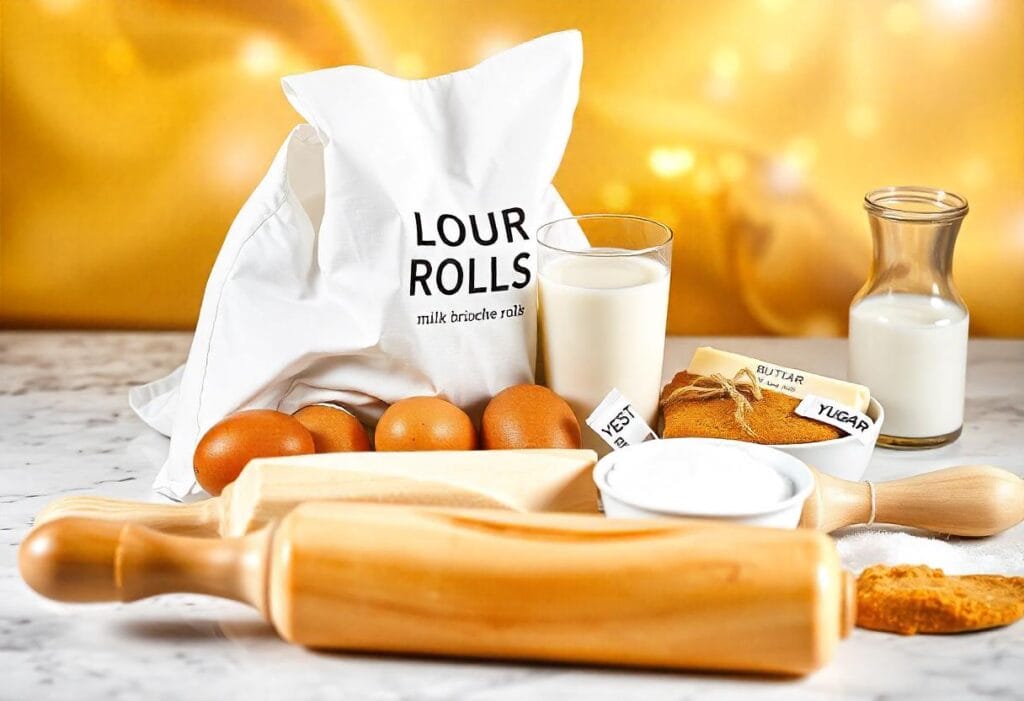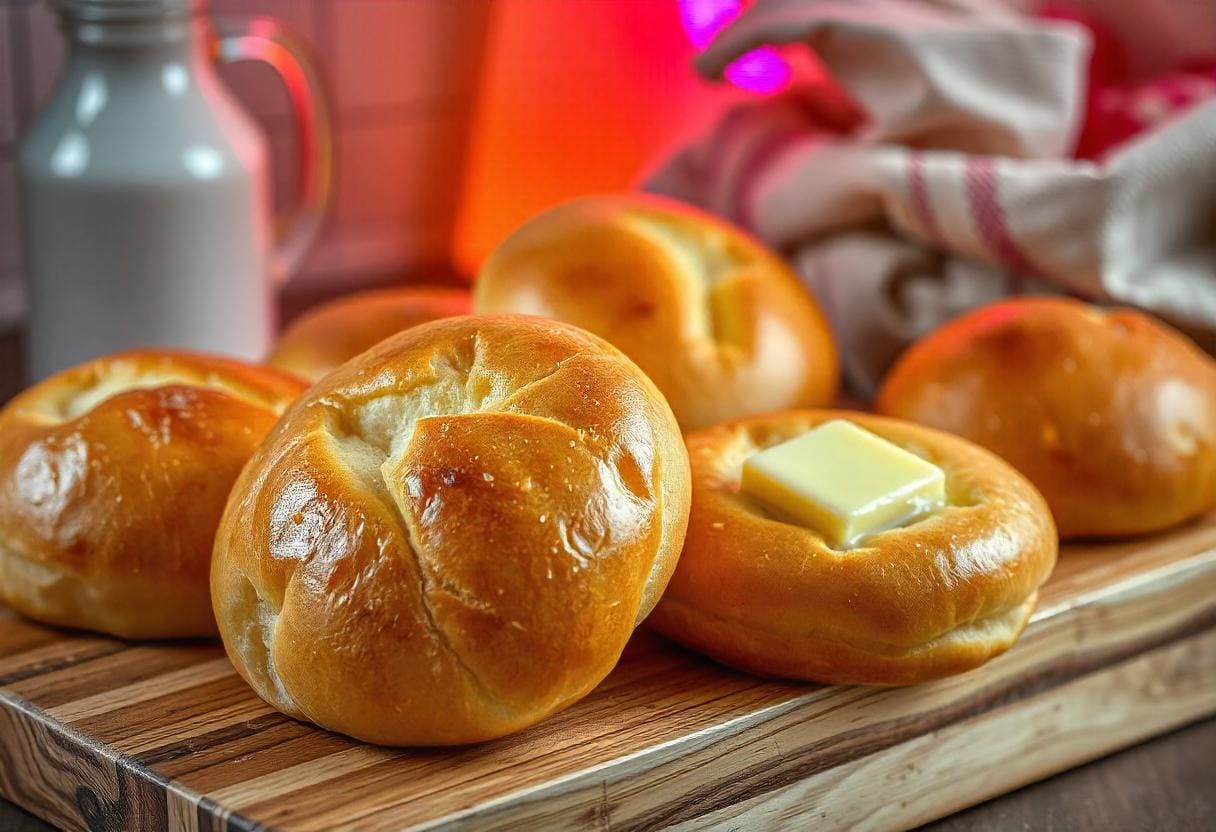Milk brioche rolls are the epitome of comfort food—a harmonious blend of fluffy texture, rich flavor, and an irresistible golden crust. These soft, slightly sweet rolls are a favorite across breakfast tables, afternoon tea spreads, and holiday feasts alike. Whether enjoyed warm with a pat of butter or as the base for a gourmet sandwich, milk brioche rolls always steal the show.
But what makes these rolls so special? The secret lies in their enriched dough, crafted with ingredients like milk, butter, and eggs. This combination creates a luxurious texture that’s tender yet sturdy enough for endless culinary applications. From their French origins to modern kitchens worldwide, milk brioche rolls have cemented their place as a timeless classic.
In this article, we’ll take a deep dive into the world of milk brioche rolls—exploring their history, ingredients, step-by-step preparation, and creative variations. Whether you’re a seasoned baker or a curious beginner, this guide will provide everything you need to create bakery-quality rolls at home. Ready to embark on this delightful journey? Let’s roll!
The Origins of Brioche Rolls
History of Brioche
Brioche, with its buttery richness and tender crumb, is deeply rooted in French culinary tradition. This iconic bread first emerged in the 15th century, gaining popularity across Europe as a symbol of indulgence and sophistication. Its name derives from the Old French word « brier, » meaning « to knead, » which emphasizes the importance of technique in creating its signature texture.
Historically, brioche was a luxurious treat reserved for special occasions like weddings, religious holidays, or royal feasts. Over time, its appeal expanded, and it became a staple in French bakeries. The addition of milk to the dough marked an evolution in the recipe, resulting in milk brioche rolls, celebrated for their extra softness and delicate sweetness.
What Makes Brioche Unique?
Unlike traditional bread, brioche is classified as an enriched dough due to the high content of eggs, butter, and milk. These ingredients give it a tender texture, golden color, and a flavor profile that borders on dessert-like without being overly sweet. The milk, in particular, adds a velvety richness and enhances its shelf life, making the rolls soft for longer periods.
What truly sets brioche apart is its versatility. From simple dinner rolls to elaborate stuffed pastries, brioche is a blank canvas for both sweet and savory creations. The milk brioche roll, with its small size and pillowy texture, is an approachable and practical way to enjoy this luxurious bread at home.
Ingredients for Perfect Milk Brioche Rolls
Essential Ingredients
Creating the perfect milk brioche rolls starts with selecting the right ingredients. Each plays a crucial role in achieving the luxurious texture and rich flavor that make these rolls stand out. Here’s a breakdown of what you’ll need:
- Flour: Use bread flour for its high protein content, which helps build the structure of the rolls. If unavailable, all-purpose flour can be a substitute, but it may result in a slightly less chewy texture.
- Milk: Whole milk is ideal for its fat content, which adds richness and softness. It also contributes to the roll’s slight sweetness and ensures a moist crumb.
- Butter: Unsalted butter is a key ingredient in brioche dough. It provides a velvety texture and rich taste, balancing the dough’s sweetness.
- Eggs: The eggs in brioche add flavor, color, and structure. They also help create the characteristic golden hue of the rolls.
- Sugar: A small amount of sugar lends a hint of sweetness, making these rolls perfect for both sweet and savory pairings.
- Yeast: Active dry yeast or instant yeast is necessary for leavening the dough and creating the light, airy texture of the rolls.
- Salt: While often overlooked, salt enhances the flavor of all the other ingredients, preventing the rolls from tasting overly bland or sweet.
The Importance of Milk in Brioche
Milk is a defining ingredient in milk brioche rolls. Beyond its obvious role in hydration, it contributes to the dough’s softness and flavor. The natural sugars in milk help with browning, creating that beautifully golden crust. Additionally, milk proteins strengthen the dough, making it elastic yet tender—perfect for the soft and fluffy texture these rolls are known for.
Using milk also elevates the shelf life of brioche rolls. The fat content locks in moisture, keeping them fresh for longer compared to water-based bread. For those avoiding dairy, plant-based milks like almond or oat can be used as a substitute, though they may slightly alter the flavor.
Step-by-Step Guide to Making Milk Brioche Rolls
Creating milk brioche rolls at home requires patience and attention to detail, but the results are worth every effort. Follow this detailed step-by-step guide to achieve perfect rolls with a soft, airy texture and rich flavor.

Preparing the Dough
- Gather Ingredients: Measure your ingredients carefully. For a standard batch, you’ll need:
- 4 cups (500g) bread flour
- 1/3 cup (70g) sugar
- 2 1/4 tsp (7g) active dry yeast
- 1 tsp salt
- 3/4 cup (180ml) warm milk
- 4 large eggs
- 1/2 cup (115g) unsalted butter, softened and cut into small cubes
- Activate the Yeast: In a small bowl, combine the warm milk (not too hot, around 110°F or 43°C) with a teaspoon of sugar and the yeast. Let it sit for 5-10 minutes until frothy. This step ensures your yeast is alive and ready to work.
- Mix Dry Ingredients: In a large mixing bowl or stand mixer, combine the flour, remaining sugar, and salt. Mix until evenly distributed.
- Combine Wet Ingredients: Add the activated yeast mixture and eggs to the dry ingredients. Mix on low speed (or stir manually with a wooden spoon) until a shaggy dough forms.
- Incorporate Butter: Gradually add the softened butter, a few cubes at a time, while continuing to mix. Ensure each addition is fully incorporated before adding more. The dough will become smooth, shiny, and slightly sticky.
Kneading and Proofing
- Knead the Dough: Transfer the dough to a lightly floured surface if kneading by hand or use the dough hook attachment on a stand mixer. Knead for 8-10 minutes until the dough is elastic and smooth. It should pass the “windowpane test”—stretch a small piece of dough between your fingers; if it stretches thin enough to let light through without tearing, it’s ready.
- First Proofing: Place the dough in a lightly greased bowl and cover it with plastic wrap or a damp cloth. Let it rise in a warm, draft-free area for 1-2 hours or until it doubles in size.
Shaping and Baking
- Divide the Dough: Once risen, punch down the dough to release excess air. Turn it out onto a floured surface and divide it into 12-16 equal portions, depending on your preferred roll size.
- Shape the Rolls: Roll each portion into a smooth ball. To achieve a uniform shape, cup your hand over the dough piece and roll it gently on the surface in a circular motion.
- Second Proofing: Arrange the rolls on a parchment-lined baking sheet or in a greased baking dish, leaving enough space for them to expand. Cover loosely with plastic wrap and let rise for another 30-45 minutes until puffy.
- Egg Wash: In a small bowl, whisk one egg with a tablespoon of milk. Brush this mixture gently over the tops of the rolls to give them a shiny, golden finish.
- Bake: Preheat your oven to 375°F (190°C). Bake the rolls for 15-20 minutes or until they are golden brown and emit a tempting aroma. To check for doneness, tap the bottom of a roll—it should sound hollow.
- Cool and Enjoy: Remove the rolls from the oven and let them cool slightly before serving. They’re best enjoyed warm but can also be stored for later use.
Tips for Perfecting Milk Brioche Rolls
Making milk brioche rolls requires precision and a bit of practice, but a few expert tips can make the process easier and more successful. Here are some common challenges, troubleshooting solutions, and tricks to ensure your rolls turn out perfectly every time.

Common Mistakes to Avoid
- Using Incorrect Temperatures for Yeast: Yeast is a sensitive ingredient. If the milk is too hot, it can kill the yeast; if too cold, it won’t activate. Aim for milk that’s warm to the touch, around 100-110°F (37-43°C).
- Under-Kneading the Dough: The kneading process develops the gluten structure, which gives the rolls their elasticity and soft crumb. Insufficient kneading can lead to dense rolls. Ensure the dough passes the “windowpane test.”
- Skipping Proofing Steps: Proofing allows the yeast to do its job, creating air pockets that make the rolls light and fluffy. Skipping or rushing proofing will result in heavy, dense rolls.
- Overproofing the Dough: While proofing is crucial, overproofing can lead to deflated rolls that spread out rather than rise in the oven. Keep an eye on the dough, and test by gently pressing a finger into it—the indent should bounce back slowly.
- Incorrect Egg Wash Application: Applying too much or too little egg wash can affect the appearance of the rolls. Use a light, even layer for a shiny golden crust.
Tricks for Light and Fluffy Rolls
- Room Temperature Ingredients: Ensure all ingredients (except for milk) are at room temperature. Butter and eggs mix more seamlessly with the dough, improving its texture.
- Use High-Quality Ingredients: Opt for fresh, high-quality butter, milk, and eggs. The richness of these ingredients directly impacts the flavor and texture of the rolls.
- Allow Time for Proofing: Be patient during the proofing stages. A slow, steady rise helps develop flavor and ensures a light, airy crumb.
- Hydration Balance: If your dough feels dry, add a tablespoon of milk at a time until it becomes smooth and slightly sticky. Conversely, if the dough is too sticky to handle, dust it lightly with flour.
- Control the Baking Environment: Use a preheated oven to ensure even baking. If your oven has hot spots, rotate the baking sheet halfway through cooking for uniform coloring.
- Softening After Baking: For ultra-soft rolls, lightly brush the tops with melted butter as soon as they come out of the oven. This not only enhances the flavor but also adds a touch of softness to the crust.
Troubleshooting Guide
- Flat or Dense Rolls: Check the yeast’s expiration date and proofing times. Flat rolls are often a sign of inactive yeast or insufficient proofing.
- Cracked Tops: This could result from underproofing or shaping the rolls too tightly. Be gentle during shaping, and ensure the dough has ample time to rise.
- Dry Texture: This could be due to overbaking. Keep a close eye on the rolls, and remove them from the oven as soon as they turn golden.
By keeping these tips in mind, you’ll master the art of making milk brioche rolls that are as delicious as they are beautiful.
Variations of Milk Brioche Rolls
One of the best things about milk brioche rolls is their versatility. Their rich and tender texture provides the perfect base for a range of creative variations, from sweet indulgences to savory twists. Here are some ideas to inspire your baking adventures.

Sweet Additions
- Chocolate Chip Brioche Rolls
Add a handful of chocolate chips to the dough just before shaping the rolls. The chocolate melts into the fluffy interior, creating pockets of sweetness that make these rolls irresistible for breakfast or dessert. - Cinnamon-Sugar Swirls
Roll the dough into a rectangle, sprinkle generously with a mixture of cinnamon and sugar, and roll it up tightly. Slice into spirals and bake as usual. These rolls offer a hint of spice and sweetness reminiscent of cinnamon buns. - Fruit-Filled Brioche
Incorporate dried fruits like raisins, cranberries, or chopped apricots into the dough. For a fresh take, add a spoonful of fruit preserves or jam to the center of each roll before shaping. - Glazed Brioche Rolls
After baking, drizzle the rolls with a glaze made from powdered sugar and a touch of milk or lemon juice. This adds a glossy finish and enhances the sweetness.
Savory Twists
- Cheese-Stuffed Rolls
Place a small cube of your favorite cheese (cheddar, gouda, or mozzarella) in the center of each dough ball before shaping. As they bake, the cheese melts, creating a gooey, savory center. - Herb-Infused Brioche Rolls
Mix chopped fresh herbs like rosemary, thyme, or chives into the dough. Alternatively, sprinkle herbs on top before baking for a fragrant, savory variation. - Garlic Butter Brioche
Brush the rolls with garlic-infused butter just before and after baking. For extra flavor, sprinkle grated parmesan or a pinch of sea salt on top. - Sun-Dried Tomato and Olive Rolls
Fold chopped sun-dried tomatoes and olives into the dough. These Mediterranean-inspired rolls pair wonderfully with soups, salads, or a charcuterie board.
Seasonal or Thematic Variations
- Pumpkin Spice Brioche
Add pumpkin puree and a pinch of pumpkin spice to the dough for a fall-inspired treat. A cinnamon glaze on top completes the festive flavor profile. - Easter Brioche Nests
Shape the dough into braided rings and place a dyed egg in the center before baking. These make a delightful addition to holiday spreads. - Holiday Brioche Rolls
Infuse the dough with warm spices like nutmeg and allspice, and mix in candied orange peel or ginger. Top with a dusting of powdered sugar after baking for a festive touch.
Customization Tips
- Experiment with Fillings: From chocolate ganache to pesto, there’s no limit to the fillings you can try.
- Adjust Sweetness Levels: Depending on the recipe, you can add or reduce sugar to suit your taste preferences.
- Play with Shapes: Beyond classic round rolls, experiment with braids, knots, or twisted designs for a more decorative presentation.
Try something sweet and spiced with this delightful apple cinnamon brioche roll recipe, perfect for cozy mornings or afternoon treats 🔗 Apple cinnamon brioche roll
Whether you’re craving something sweet or savory, there’s a version to suit every occasion.
Serving Ideas for Milk Brioche Rolls
For more serving inspiration, see how to eat milk brioche rolls in creative ways from breakfast to dessert 🔗 How do you eat milk brioche rolls
Whether served as a simple side dish or transformed into a creative centerpiece, these fluffy rolls are sure to impress. Here are some serving suggestions to elevate your brioche experience.
Pairing Suggestions
- With Breakfast
- Butter and Jam: Warm brioche rolls served with a pat of butter and your favorite jam are a simple yet indulgent way to start the day.
- Eggs and Bacon: Pair them with scrambled eggs and crispy bacon for a hearty breakfast.
- As a Snack or Afternoon Treat
- Coffee or Tea Companion: Their light sweetness makes them an ideal partner for coffee, tea, or hot chocolate.
- With Nut Spreads: Spread peanut butter, almond butter, or hazelnut chocolate spread on a toasted roll for a quick snack.
- At Dinner
- Soup Sidekick: Use them to mop up hearty soups or creamy chowders.
- Holiday Dinners: Serve them alongside turkey, ham, or roast beef for a festive touch.
- As a Dessert Base
- With Ice Cream: Split a roll, toast it lightly, and serve it with a scoop of ice cream and a drizzle of caramel or chocolate sauce.
- French Toast: Repurpose day-old rolls into rich, custardy French toast.
Creative Uses
- Sandwiches and Sliders
Their soft, slightly sweet flavor pairs beautifully with savory fillings like grilled chicken, pulled pork, or veggie patties. Mini brioche sliders are a hit at parties and barbecues. - Bread Pudding
Transform leftover rolls into a decadent dessert by layering them with custard and baking until golden and bubbly. Add raisins or chocolate chips for extra flavor. - Mini Burgers
Use them as buns for gourmet burgers. Their delicate texture complements juicy patties and toppings like caramelized onions, blue cheese, or avocado. - Savory Bread Bowls
Hollow out larger brioche rolls and fill them with creamy dips, stews, or chili. They’re a fun and edible serving option for gatherings. - Stuffed Rolls
Split the rolls and fill them with whipped cream, mascarpone, or sweet custards for a sophisticated dessert.
Seasonal Serving Ideas
- Spring and Summer: Pair with fresh fruit salads, chilled lemonades, or light yogurt dips.
- Autumn and Winter: Serve warm with hearty stews, mulled cider, or creamy hot chocolates.
By experimenting with these serving ideas, you’ll discover just how versatile and delightful milk brioche rolls can be. Whether enjoyed on their own or as part of a creative dish, they’re sure to leave a lasting impression on your taste buds.
Frequently Asked Questions
Milk brioche rolls may seem simple, but there are many nuances to their preparation, storage, and versatility. Here are answers to some of the most common questions to help you perfect your brioche experience.
How Long Do Milk Brioche Rolls Stay Fresh?
Milk brioche rolls typically stay fresh for 2-3 days when stored properly. Keep them in an airtight container or a resealable plastic bag at room temperature. Avoid refrigerating them, as this can dry out the bread. To extend their freshness, you can freeze them (more on that below).
Can I Freeze Brioche Rolls?
Yes, milk brioche rolls freeze beautifully! To freeze:
- Let the rolls cool completely after baking.
- Wrap each roll individually in plastic wrap or foil to prevent freezer burn.
- Place the wrapped rolls in a resealable freezer bag or airtight container.
They can be stored in the freezer for up to 3 months. To reheat, let them thaw at room temperature and warm them in the oven at 350°F (175°C) for a few minutes.
What’s the Best Flour for Brioche?
Bread flour is the best choice for milk brioche rolls because of its high protein content, which creates a strong gluten structure. If you want a softer texture or a slightly denser crumb, you can mix bread flour with all-purpose flour in a 50:50 ratio.
Why Didn’t My Dough Rise?
If your dough didn’t rise, several factors might be at play:
- Inactive Yeast: Check the expiration date and ensure the yeast was properly activated in warm milk (100-110°F or 37-43°C).
- Cold Environment: Yeast thrives in warmth. If your kitchen is cold, try proofing the dough in a warm spot, such as near a sunny window or inside an oven with the light turned on.
- Salt Contact: If salt was added directly to the yeast, it could inhibit its activity. Always mix salt into the dry ingredients before combining with the yeast.
Can I Use Plant-Based Milk?
Absolutely! Plant-based milks like almond, soy, oat, or coconut milk can be used instead of dairy milk. Keep in mind that each will slightly alter the flavor. For example:
- Almond Milk: Adds a subtle nuttiness.
- Coconut Milk: Lends a rich, tropical flavor.
- Oat Milk: Creates a neutral, creamy taste similar to dairy milk.
How Do I Achieve the Perfect Golden Top?
The secret to that beautiful golden crust lies in the egg wash. Here’s how to do it:
- Whisk together one egg and one tablespoon of milk until smooth.
- Use a pastry brush to apply a thin, even layer over the rolls just before baking.
- For extra shine, apply a second coat halfway through baking.
Can I Make the Dough Ahead of Time?
Yes, milk brioche dough can be prepared in advance! After kneading, cover the dough tightly and refrigerate it for up to 24 hours. This slow fermentation enhances the flavor. When ready to bake, let the dough come to room temperature and rise until doubled in size before shaping.
Are Milk Brioche Rolls Suitable for Vegans?
Traditional milk brioche rolls are not vegan because they contain eggs, butter, and milk. However, you can make vegan-friendly rolls by substituting:
- Eggs with flaxseed meal or applesauce.
- Butter with plant-based margarine or coconut oil.
- Milk with any plant-based alternative.
These FAQs cover the most common challenges and adaptations when making milk brioche rolls. With these answers in hand, you’re ready to tackle any brioche-related question that comes your way!
Conclusion
If you’re curious about the difference between brioche and milk buns, this article offers a detailed comparison that highlights what makes each unique🔗What is the difference between brioche and milk
Whether you’re savoring them plain, stuffing them with sweet or savory fillings, or pairing them with your favorite dishes, these versatile rolls can elevate any meal or occasion.
you might also enjoy this helpful guide on the difference between brioche and bread rolls to explore further texture and ingredient contrasts 🔗 What is the difference between brioche and bread rolls
You now have all the tools to create bakery-quality brioche rolls at home. Remember, patience and precision are key—good things take time, and your efforts will be rewarded with the soft, golden rolls of your dreams.
Explore the endless variations to customize your brioche rolls and experiment with serving ideas to suit your taste and creativity. By following the tips, troubleshooting solutions, and nutritional advice shared here, you can enjoy milk brioche rolls as a treat that’s both indulgent and rewarding.
So, roll up your sleeves, preheat the oven, and start baking! These milk brioche rolls are sure to become a cherished addition to your culinary repertoire.

